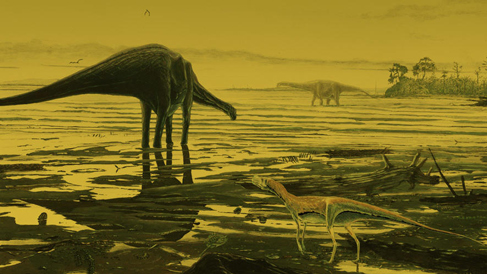Scotland’s Own and Unique “Jurassic Park”
Jurassic Fossils from the Isle of Skye Globally Significant
The filming might have resumed for the next instalment in the “Jurassic Park/World” franchise last week, but in the scientific community there has been an important development in the study and protection of Scotland’s very own “Jurassic Park”.
Significant Jurassic Fossils
Scientists from the University of Oxford, University College London, Birmingham University the University of Edinburgh and the National Museum of Scotland have published a new scientific paper that emphasises the importance of vertebrate fossils from the Isle of Skye.
The Isle of Skye is Heralded as One of the Most Important Places in the World for Middle Jurassic Vertebrate Fossils

Picture credit: Jon Hoad
The Kilmaluag Formation
Outcrops of the Bathonian-aged Kilmaluag Formation on the Trotternish peninsula on the Isle of Skye hold vital information on how vertebrate life was evolving and changing around 167 million years ago. The strata contain both body and trace fossils of numerous tetrapods including dinosaurs. Since there are not that many highly fossiliferous sites around the world providing evidence of terrestrial ecosystems and biota from back in the Middle Jurassic, the Isle of Skye has long been recognised as a hugely significant.
The area was given greater legal protection last year, when the Scottish Government signed a Nature Conservation Order (NCO), to assist in the protection of the rare vertebrate fossils found in the area and to deter irresponsible fossil collecting on the island.
To read about the provision of the Nature Conservation Order: Legal Protection for Isle of Skye Fossil Sites.
In this new study, the researchers which include Scottish palaeontologist Elsa Panciroli, a research assistant in the department of Evolution and Palaeobiology at the University of Oxford, conclude that unlike other contemporaneous fossil localities from England, the strata of the Kilmaluag Formation provides partial skeletons, providing unprecedented insights and new data.
An Abundant Assemblage of Jurassic Fossils
The research team state that this location has yielded predominantly small-bodied tetrapods including amphibians, many types of reptiles (including pterosaurs and dinosaurs) and non-mammalian cynodonts as well as early mammals. An abundant fossil fish and invertebrate assemblage is also reported.
A Sauropod Track from the Isle of Skye

Picture credit: Jon Hoad
The researchers provide a comprehensive overview of the Kilmaluag Formation, outlining the importance of its geology and the fossil discoveries made to date. They also present evidence of several species that are being reported from the Isle of Skye for the first time. The review places the vertebrate faunal assemblage in an international context and confirms the global significance of the region.
Insights into Early Mammal Evolution
Although the dinosaurs grab all the headlines, the Kilmaluag Formation is most likely to provide important information with regards to the evolutionary history of early mammals, the Squamata (lizards and snakes) along with amphibians.
To read Everything Dinosaur’s blog post about damage to dinosaur footprints being reported: Dinosaur Footprints Damaged on the Isle of Skye.
The link between the fossil sites in Wyoming and the Isle of Skye: What have Wyoming and the Isle of Skye got in Common?
Evidence of Scottish Stegosaurs: Scottish Stegosaurs.
The scientific paper: “Diverse vertebrate assemblage of the Kilmaluag Formation (Bathonian, Middle Jurassic) of Skye, Scotland” by Elsa Panciroli, Roger B. J. Benson, Stig Walsh, Richard J. Butler, Tiago Andrade Castro, Marc E. H. Jones and Susan E. Evans published by The Royal Society of Edinburgh/Cambridge University Press.
The Everything Dinosaur website: Everything Dinosaur.

